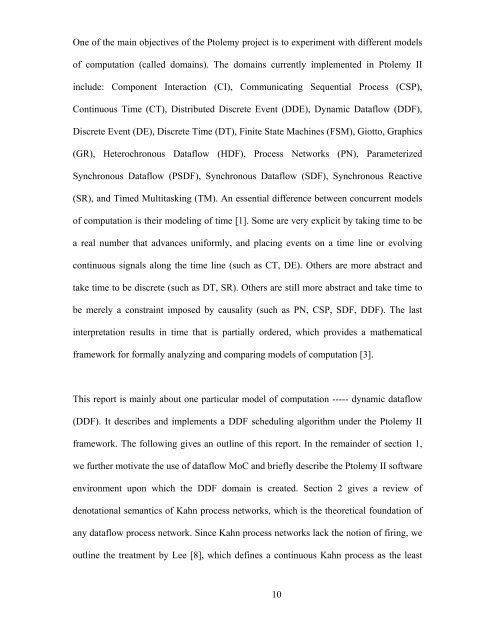Dynamic Dataflow Modeling in Ptolemy II - Ptolemy Project ...
Dynamic Dataflow Modeling in Ptolemy II - Ptolemy Project ...
Dynamic Dataflow Modeling in Ptolemy II - Ptolemy Project ...
Create successful ePaper yourself
Turn your PDF publications into a flip-book with our unique Google optimized e-Paper software.
One of the ma<strong>in</strong> objectives of the <strong>Ptolemy</strong> project is to experiment with different models<br />
of computation (called doma<strong>in</strong>s). The doma<strong>in</strong>s currently implemented <strong>in</strong> <strong>Ptolemy</strong> <strong>II</strong><br />
<strong>in</strong>clude: Component Interaction (CI), Communicat<strong>in</strong>g Sequential Process (CSP),<br />
Cont<strong>in</strong>uous Time (CT), Distributed Discrete Event (DDE), <strong>Dynamic</strong> <strong>Dataflow</strong> (DDF),<br />
Discrete Event (DE), Discrete Time (DT), F<strong>in</strong>ite State Mach<strong>in</strong>es (FSM), Giotto, Graphics<br />
(GR), Heterochronous <strong>Dataflow</strong> (HDF), Process Networks (PN), Parameterized<br />
Synchronous <strong>Dataflow</strong> (PSDF), Synchronous <strong>Dataflow</strong> (SDF), Synchronous Reactive<br />
(SR), and Timed Multitask<strong>in</strong>g (TM). An essential difference between concurrent models<br />
of computation is their model<strong>in</strong>g of time [1]. Some are very explicit by tak<strong>in</strong>g time to be<br />
a real number that advances uniformly, and plac<strong>in</strong>g events on a time l<strong>in</strong>e or evolv<strong>in</strong>g<br />
cont<strong>in</strong>uous signals along the time l<strong>in</strong>e (such as CT, DE). Others are more abstract and<br />
take time to be discrete (such as DT, SR). Others are still more abstract and take time to<br />
be merely a constra<strong>in</strong>t imposed by causality (such as PN, CSP, SDF, DDF). The last<br />
<strong>in</strong>terpretation results <strong>in</strong> time that is partially ordered, which provides a mathematical<br />
framework for formally analyz<strong>in</strong>g and compar<strong>in</strong>g models of computation [3].<br />
This report is ma<strong>in</strong>ly about one particular model of computation ----- dynamic dataflow<br />
(DDF). It describes and implements a DDF schedul<strong>in</strong>g algorithm under the <strong>Ptolemy</strong> <strong>II</strong><br />
framework. The follow<strong>in</strong>g gives an outl<strong>in</strong>e of this report. In the rema<strong>in</strong>der of section 1,<br />
we further motivate the use of dataflow MoC and briefly describe the <strong>Ptolemy</strong> <strong>II</strong> software<br />
environment upon which the DDF doma<strong>in</strong> is created. Section 2 gives a review of<br />
denotational semantics of Kahn process networks, which is the theoretical foundation of<br />
any dataflow process network. S<strong>in</strong>ce Kahn process networks lack the notion of fir<strong>in</strong>g, we<br />
outl<strong>in</strong>e the treatment by Lee [8], which def<strong>in</strong>es a cont<strong>in</strong>uous Kahn process as the least<br />
10
















